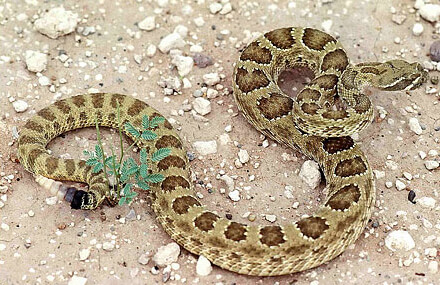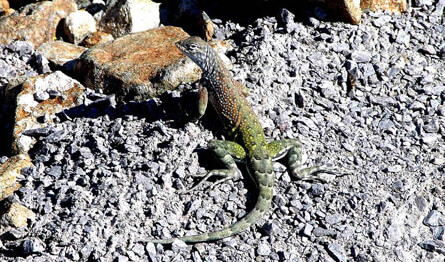What Do Animals Eat In The Desert

How Animals Survive in the Desert
The Desert Nutrient Concatenation Part 4
Similar plants, called producers, animals, chosen consumers, have developed complex ways to survive the prolonged droughts and high temperatures of the Southwestern deserts.

The prickly pear cactus, a juicy food for insects, birds and mammals.
Cacti, yuccas and agaves take adult specialized stem or leafage structures that store the water necessary to come across them through drought and heat. Some shrubs go dormant, effectively going to slumber, dropping their leaves and stems to reduce their needs for water during periods of drought and rut. Other plants, like California poppies, indian paintbrushes or bluebonnets, sprout their seeds but when conditions are platonic, growing into new plants, flowering, and producing new seeds swiftly, avoiding the desert'south total measure of drought and heat.
Animals are mobile organisms and have more than specialized tissue structures but less estrus tolerance than plants. They have developed their own sets of strategies for acquiring and conserving their water supplies and avoiding or escaping drought and heat.
Video on How the Desert Food Chain Works
Acquiring and Managing Water
Many animals have advantage of the water freely bachelor in the Southwest's few continuously flowing river systems and temporary drainages and ponds. The animals and plants that alive along stream banks and marshes, or riparian environments, constitute the most abundant and diverse biological communities in the desert basins. The animals that live in the vast desert areas betwixt the river systems, notwithstanding, must look to other sources for water.

Tarantula, a banquet for the tarantula hawk's immature.
Some acquire water from the plants or animals they consume.
The large, metallic greenish scarab chosen the green fruit beetle is a native of the Chihuahuan and Sonoran Deserts. Information technology feeds on the prickly pear cacti's juicy fruits, which are a source of moisture for information technology, too as nutrition. The desert tortoise, a reptile, takes well-nigh of its moisture from its foods, which include grasses, wildflowers and cacti.
The hummingbird takes water and calories from the nectar of flowers. With a eye that throbs at a rate of more than a 1000 times a minute and wings that whir at a rate of 80 beats a second, the hummer uses and so much energy that it must visit 1000 flowers a day to get the nectar it needs to survive.
Other animals rely on the creatures they eat for moisture. The tarantula wasp ambushes its spider prey well-nigh its burrow. Information technology stings the tarantula, paralyzing rather than killing it. Information technology drags the withal-living only now immobile spider home, stuffing information technology into the earthen hole. It lays its eggs on the spider's body. When the eggs hatch, the wasp's larvae feed on the paralyzed and helpless tarantula, taking their moisture and nutrition from the creature'southward tissue.

The western rattlesnake takes moisture from its prey.
The western rattlesnake absorbs most of its water from its casualty, unremarkably small mammals and birds, which it swallows whole. In the form of a year, the rattler will take in an amount of water roughly equivalent to its trunk weight.
The desert martin, or majestic martin, is a migratory bird that arrives in the Sonoran Desert from South America in late spring and nests in the towering saguaro cactus. It gets wet for itself and its immature birds from insect casualty.
The roadrunner is ofttimes depicted as a featherbrained bird in cartoons but is actually a creature superbly adapted to the desert. It takes its h2o and nutrition from various prey – scorpions, reptiles (even rattlesnakes), small rodents and other birds.

The scorpion, one of the roadrunner'due south preys and a source of wet.
The turkey vulture, a desert scavenger with a wing bridge of six feet, takes much of its moisture from the dead fauna carcasses, or carrion. Co-ordinate to 8-year-old Katelyn Martin in her poem The Road Kill Grill, published in DesertUSA, "Dead meat in the heat for the turkey vulture is a treat."
Bats, the merely winged mammal, usually skim streams or ponds for water. Some desert species of bat however, rely only on insect casualty for the moisture they need. The long-nose bat of south-central Arizona and southwestern New Mexico, gets its required wet from the blooms of saguaro and organ pipe cacti and agaves and, after the flowering season, from the ripe fruit of the cacti.
Stone squirrels live in the rocky arroyos and hills of the northern Chihuahuan and Sonoran deserts. They become water from grasses, juicy vegetation and institute bulbs. The rock squirrel may non even bother to beverage water available from nearby ponds and streams.
The tough-snouted, pig-like collared peccary often travels in groups of upwards to 10 or even 50 animals. Likewise known as javelinas, they get water from the plants of their diverse nutrition, a thorny feast that includes various prickly pears, the sotol and the thorny lechuguilla agave.
The agile bighorn sheep, among the heartiest of the larger mammals of the desert, also gets water from its widely varied nutrition, which includes plants such every bit mountain mahogany, prickly pear cacti and various yuccas and agaves.
While many desert animals meet their h2o needs from their diet, others have bodies especially adjusted for managing h2o. A beetle has a hard shell, or external skeleton, that encases its body and reduces wet loss. The scaly skin of reptiles helps retain wet. The gila monster, which tin consume equally much as 100 pct of its body weight, tin can shop plenty h2o in its body to last through a whole wintertime. Roadrunners can reabsorb h2o from their own waste. The turkey vulture has very powerful kidneys that allow the bird to dispose of its body waste material as solid affair while conserving h2o. The desert kangaroo rat can convert dry seed affair into water during the process of digestion, and has kidneys designed to dispose of waste while conserving water.
Avoiding and Managing Heat Exposure
Desert animals have developed another range of strategies for dealing with the searing heat, which may reach air temperatures of well over 100 degrees Fahrenheit and soil temperatures of well over 150 degrees.

Reptiles, such every bit this earless lizard, have scaly skins that help retain wet.
Many animals take refuge in their relatively cool burrows, well beneath the hot surface during the day, and come up out at dark to hunt or forage. Arizona's hairy scorpion, which can grow upwards to vi inches in length, digs burrows as much every bit 8 feet deep to escape the oestrus. The gila monster, which must maintain a body temperature in the range of 85 degrees, spends much of the summer days in a cool earthen burrow, one probably stolen from a packrat. The burrowing owl and the black-throated sparrow will take over rodent'south burrows to get relief from the desert lord's day. Diverse mammals, from rodents like the desert kangaroo rat to larger animals like skunks and foxes dig their own burrows to serve equally retreats from the estrus of summertime days. Some animals, various ground squirrels for example, spend well-nigh of the summertime in their burrows, living hush-hush for nearly the entire season of heat.
All mode of other animals simply seek out the relative coolness of whatsoever shade they tin discover in the desert. Some birds absurd themselves by panting to cause the water in their throats and mouths to evaporate, carrying estrus away from their bodies and into the air. A turkey vulture expels waste product onto its own legs, depending on the evaporation of the moisture to carry away torso rut. Some birds migrate to libation regions or retreat to mountain elevations to avoid the summer heat. The mule deer, the collared peccary and other animals may motility to higher and cooler country. The desert bighorn sheep may seek the coolness, not of burrows, but of caves in the mountain foothills during the heat of summertime.

The nimble deer seeks higher and cooler land as a refuge from the heat of a desert summertime.
Many desert animals have bodies specially adjusted to withstand heat. Birds often have low-cal-colored feather and animals, lite-colored coats, which tend to reflect rather than absorb rut. Others have few sweat glands then they can avoid losing water by perspiration. The black-tailed jackrabbit has very large ears that disperse the animal'south body heat into the desert air.

The desert cottontail makes a fine meal for a coyote.
Then Comes the Dark
After spending the 24-hour interval in refuge from the summer estrus, desert animals begin to emerge equally the sun descends in the w and the air and soil temperatures begin to autumn. Moths show upward to brainstorm their business of pollinating night-blooming plants. The wolf spider climbs from his burrow to scout his territory and begin his hunt. The rattlesnakes and the gila monster commencement their evening rounds. The mammals brainstorm their business. Often, in the darkness, the coyotes yip excitedly as they shut in on a black-tail jackrabbit or a desert cottontail. It'southward night when the desert comes to life.
by Jay W. Abrupt
Food Concatenation Introduction
How Practise Light-green Plants Industry Their Ain Food?
How Do Desert Plants Survive?
How Practice Desert Animals Survive?
The Arithmetics of the Food Chain
The Nomenclature of Desert Plants & Animals
Desert Animals
Desert Plants
Related DesertUSA Pages
- How to Turn Your Smartphone into a Survival Tool
- 26 Tips for Surviving in the Desert
- Decease by GPS
- 7 Smartphone Apps to Improve Your Camping Experience
- Maps Parks and More than
- Desert Survival Skills
- How to Keep Water ice Cold in the Desert
- Desert Rocks, Minerals & Geology Alphabetize
- Preparing an Emergency Survival Kit
- Get the Best Hotel and Motel Rates
Share this folio on Facebook:
DesertUSA Newsletter -- We send articles on hiking, camping and places to explore, as well as animals, wildflower reports, institute information and much more. Sign up below or read more almost the DesertUSA newsletter here. (It's Free.)
The Desert Surround
The North American Deserts
Desert Geological Terms

Source: https://www.desertusa.com/food_chain_k12/kids_4.html
Posted by: jakubowskisuremposelve.blogspot.com

0 Response to "What Do Animals Eat In The Desert"
Post a Comment